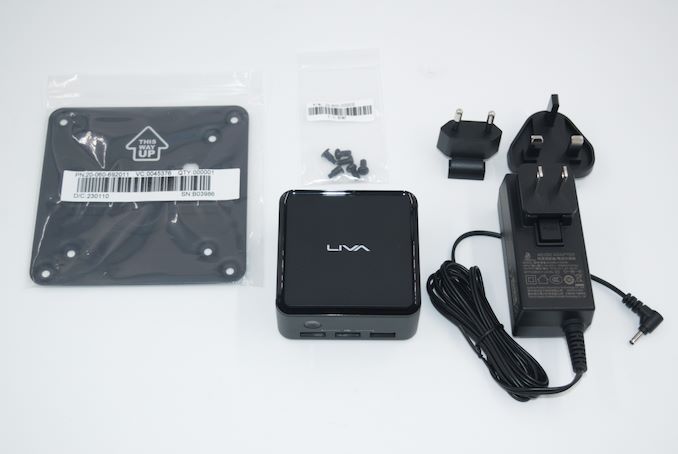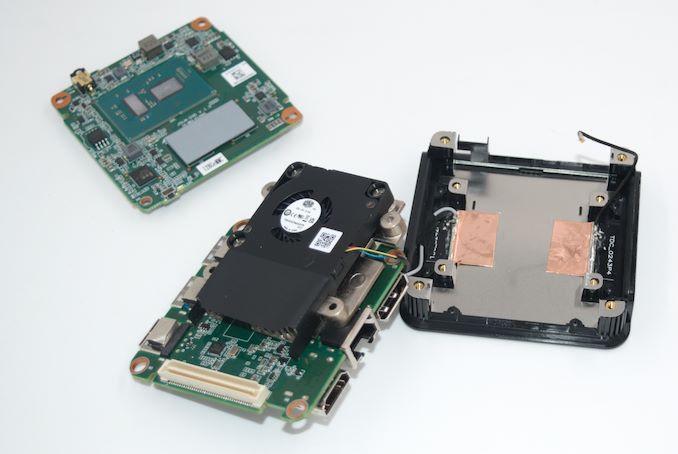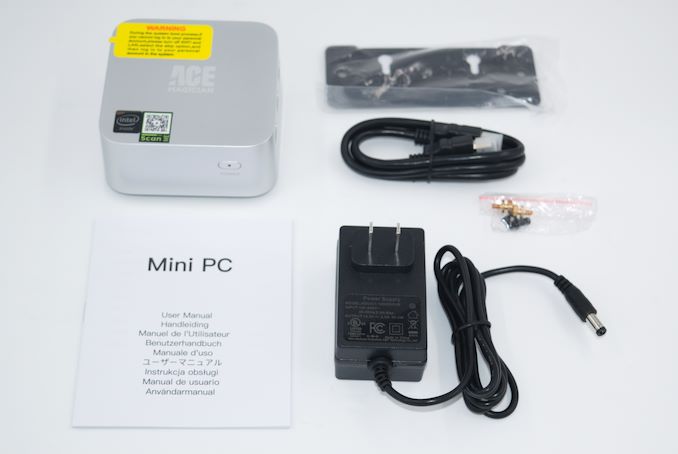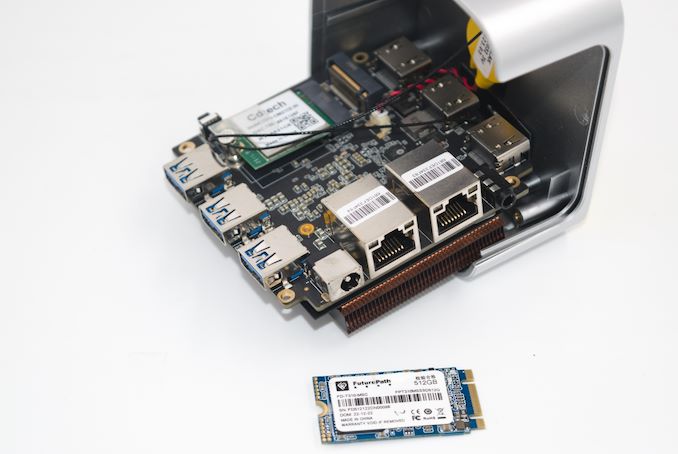Compact computing systems have gained significant market share over the last decade. Improvements in the performance per watt metric of processors have enabled the replacement of bulky desktop PCs by ultra-compact form-factor (UCFF) machines with a 4 in. x 4 in. footprint. Motivated by IoT applications at the edge, some companies such as Shuttle started creating x86 systems in sub-4×4 form-factors using Intel’s Apollo Lake processors. ECS was one of the first mainstream vendors to pay attention to this segment with their LIVA Q Series using Intel’s Atom series and AMD’s first-generation Ryzen Embedded SoCs. With the introduction of more power-efficient platforms, Asian manufacturers such as ACEMAGIC, GMKtec, and MinisForum have also entered this micro-PC market with a wider range of processor choices.
Since the introduction of Silverthorne Atom processors in 2008, Intel has been maintaining separate microarchitectures in different product families to span a wider performance / power efficiency range. As a result, consumers could either opt for a low-power low-cost platform sacrificing on performance with Atom-class CPUs or go for a more performant Core-class CPU, albeit at a higher cost with some sacrifice on the power efficiency front. From 2008 to 2020, these remained distinct product families. However, the introduction of hybrid CPUs (starting with the short-lived Lakefield) saw cores based on both microarchitectures to be placed on the same die. The Tremont microarchitecture (developed as part of the Atom-family) made its debut in Lakefield before gaining wider market presence through Jasper Lake, Elkhart Lake, and other product families. Its successor (Gracemont) is adopting a similar trajectory. After its introduction in Alder Lake, it underwent further refinement in Raptor Lake.
Intel introduced the Alder Lake-N (ADL-N) product family to take over Jasper Lake’s role in the cost-conscious low-power PC market. It is essentially an Alder Lake processor with all the performance cores removed, and a pared-down integrated GPU. As ADL-N ramps up and Jasper Lake winds down, we are seeing products based on both families being actively sold in the market. We took advantage of this opportunity to source two micro-PCs – the ECS LIVA Q3D, and the ACEMAGIC T8 Plus – and put them through our evaluation routine to study the benefits of ADL-N’s Gracemont microarchitecture over Jasper Lake’s Tremont. This review presents a detailed analysis of the results along with a discussion of the tradeoffs involved in pursuing a smaller-than-UCFF footprint.
Introduction and Product Impressions
Advancements in processor power efficiency and performance have resulted in sub-15W TDP SoCs becoming powerful enough to replace bulky desktops for many use-cases. Intel’s NUC lineup kickstarted this trend in the early 2010s, with the 4 in. x 4 in. ultra-compact form-factor (UCFF) becoming the de-facto standard for such systems. This size was arrived at keeping the I/O requirements, disk drive sizes, and ease of board design / assembly in mind. Since that time, both storage and memory technologies have evolved significantly. Most systems use M.2 SSDs nowadays, a marked shift from the 2.5″ drives common in those days. While SODIMMs continue to be the choice for systems offering memory upgrade capabilities, modern processors have started to integrate LPDDR4 / LPDDR5 support. This has resulted in a number of systems with soldered memory on board. These factors have contributed to some vendors attempting to experiment with micro-PCs – systems having a sub-4×4 footprint.
ECS LIVA Q3D
ECS has remained commited to micro-PCs since the introduction of the Apollo Lake-based LIVA Q1L. The company has followed it up with the LIVA Q2 based on the Gemini Lake refresh SoCs, the Q3 Plus based on the first-generation Ryzen Embedded SoCs, and most recently, the Jasper Lake-based LIVA Q3D. Compared to a traditional UCFF system, the LIVA Q3D series makes a couple of tradeoffs. Instead of SODIMMs, the system uses soldered LPDDR4X RAM. A M.2 SSD slot is avoided by integrating an eMMC boot drive on the board. This is complemented by a built-in microSDXC card reader. These allow the LIVA Q3D to be very compact. The 74mm x 74mm x 34.6mm (a volume of just 0.19L) system weighs just 174g.
In addition to the main unit, the LIVA Q3D package comes with a VESA mount and corresponding screws, and a 36W (12V @ 3A) wall wart. The power adapter has a replaceable plug, and ECS provides US, UK, and EU adapters. The gallery below provides a comprehensive look at the chassis design and I/O ports placement. The teardown pictures provides insights into the internals of the unit.
The teardown pictures in the above gallery show that ECS has adopted a dual-board strategy for the system. While the main board has the SoC package, RAM, and eMMC, along with the audio jack, the daughterboard has all of the other I/Os including the USB and LAN ports.
A solid heat sink is mounted with screws on top of the Jasper Lake package, and complemented by a 40mm Cooler Master blower fan to take out the heat in typical notebook style. The CMOS battery is sandwiched between the two boards and a metal shield ensures electrical interference mitigation between the components on the two boards.
ACEMAGIC T8 Plus
The T8 Plus is ACEMAGIC’s first attempt at creating a micro-PC. Like the ECS LIVA Q3D, the T8 Plus also utilizes soldered RAM. However, thanks to the newer memory support in ADL-N, the board adopts LPDDR5 RAM. A semblance of upgradability is maintained, thanks to the use of a M.2 2242 SATA SSD as a boot drive. The 89.4mm x 89.4mm x 43.4mm (0.35L) system weighs 205g.
In addition to the main unit, the T8 Plus package comes with a HDMI cable, wall mount with associated screws, an user manual, and a 30W (12V @ 2.5A) geo-specific wall wart. The gallery below provides a look at the chassis design and I/O ports placement. Teardown pictures providing insights into the internals are also included.
The pictures show the presence of a raised segment on the underside. This circular segment also includes perforations that allow for cool air to be drawn in before exiting through the copper heat spreader’s fins. Unlike the LIVA Q3D, the T8 Plus uses a single board design.
The RAM and the SoC package are under the heat sink / fans, while the M.2 2230 slot for the WLAN / BT card, and the M.2 2242 SATA SSD slot are on the other side (closer to the top panel). The pre-installed SSD is from FuturePath, but we were unable to make out the name of the controller manufacturer despite the availability of the logo in the final picture of the above gallery. The CMOS battery and the WLAN antennae are affixed to the underside of the chassis top panel.
Both systems came ready with Windows OS pre-installed. The full specifications of the two review samples (as tested) are summarized in the table below.
| Systems Specifications (as tested) | ||
| ACEMAGIC T8 Plus | ECS LIVA Q3D | |
| Processor | Intel Processor N95 Alder Lake-N 4C/4T, 1.7 – 3.4 GHz Intel 7, 6MB L3, 15W (PL1 = 15W / PL2 = 15W) | Intel Pentium Silver N6000 Jasper Lake 4C/4T, 1.1 – 3.3 GHz Intel 10nm, 4MB L3, 6W (PL1 = 10W / PL2 = 25W) |
| Memory | Samsung K3LKBKB0BM-MGCP LPDDR5-3200 (Single-Channel / 4 x16) 36-32-32-68 @ 3200 MHz 16 GB | Micron MT53E1G32D2NP-046 LPDDR4X-2933 (Single-Channel / x32) 28-27-27-62 @ 2933 MHz 4 GB |
| Graphics | Intel UHD Graphics (16EU @ 1200 MHz) | Intel UHD Graphics 605 (32EU @ 350 – 850 MHz) |
| Disk Drive(s) | Futurepath FPT310M4SSD512G (512 GB; SATA III 6 Gbps;) (?? TLC NAND; ?? Controller) | Kingston Y29128 (128 GB; eMMC 5.1 HS400;) (3D TLC; Phison PS8229 Controller) |
| Networking | 2x GbE RJ-45 (Realtek RTL8168/8111) Realtek RTL8821CE Wi-Fi 5 / Bluetooth 4.2 (1×1 802.11ac – 433 Mbps) | 1x GbE RJ-45 (Realtek RTL8168/8111) Realtek RTL8822CE Wi-Fi 5 (2×2 802.11ac – 867 Mbps) |
| Audio | 3.5mm Audio Jack Digital audio and bitstreaming support over HDMI Outputs | Digital Audio and Bitstreaming Support over HDMI and DisplayPort Outputs |
| Video | 3x HDMI 2.1 (up to 4Kp60) | 1x HDMI 2.0a 1x DisplayPort 1.4a |
| Miscellaneous I/O Ports | 3x USB 3.2 Gen 1 (5 Gbps) Type-A | 2x USB 3.2 Gen 1 Type-A (Front) 1x USB 2.0 Type-A (Front) 1x microSDXC (Side) |
| Operating System | Windows 11 Enterprise (22000.2360) | Windows 11 Enterprise (22000.2124) |
| Pricing | (Street Pricing on Sep 18th, 2023) US $207 ($177) (with limited use / limited time coupon UQSYLW9R) | US $285 (w/ 128 GB eMMC, 4GB LPDDR4X, and OS) |
| Full Specifications | ACEMAGIC T8 Plus Specifications | ECS LIVA Q3D Specifications |
In the next section, we take a look at the system setup and follow it up with a detailed platform analysis.








